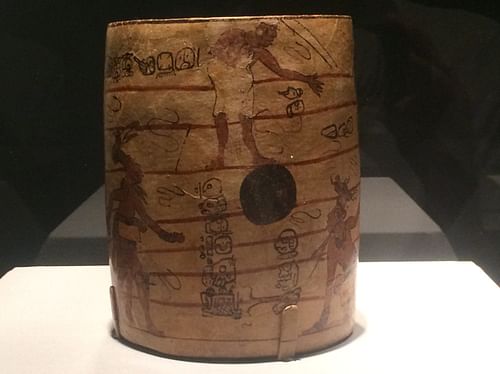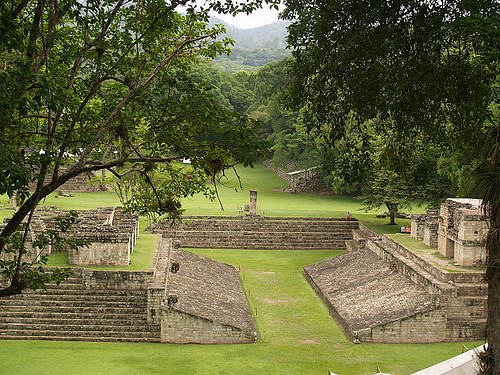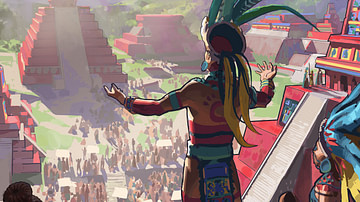
The Popol Vuh is the story of creation according to the Quiche Maya of the region known today as Guatemala. Translated as `The Council Book', The Book of the People' or, literally, `The Book of the Mat', the work has been referred to as "The Mayan Bible" although this comparison is imprecise. The Popol Vuh is not regarded by the Maya as `the word of God' nor as sacred scripture but rather as an account of "the ancient word" and the understanding the Quiche had of cosmology and creation before the coming of Christianity. The Quiche referred to the book as an Ilb'al - an instrument of sight - and it was known as "The Book of the Mat" because of the woven mats the people would sit on to hear the work recited at the council house. One such building, at Copan, features stone lintels `woven' to look like such matting.
In the beginning of Book I the unknown author states:
This is the beginning of the ancient word, here in this place called Quiche. Here we shall inscribe, we shall implant the Ancient Word, the potential and source for everything done in the citadel of Quiche, in the nation of Quiche people...We shall write about this now amid the preaching of God, in Christendom now. We shall bring it out because there is no longer a place to see it, a Council Book, a place to see "The Light That Came from Beside the Sea", the account of "Our Place in the Shadows", a place to see "The Dawn of Life", as it is called (63).
Regarding these phrases describing the Popol Vuh, the Mayanist Dennis Tedlock writes:
Because they obtained the book (or some section of it) on a pilgrimage that took them down from the highlands to the Atlantic shore, they called it "The Light That Came from Beside the Sea", because the book told of events that happened before the first true dawn, and of a time when their ancestors hid themselves and the stones that contained the spirit familiars of their gods in forests, they also called it "Our Place in the Shadows." And because it told of the rise of the morning star and the sun and moon and foretold the rise and radiant splendor of the Quiche lords, they called it "The Dawn of Life" (21).
The work recounts the creation of the world, the exploits of the hero twins Hunahpu and Xbalanque in the underworld and their triumph over the Lords of Death, the creation of humans, and the early history of Quiche migration and settlement up until the Spanish Conquest in the 16th century CE. The Spanish Bishop Diego de Landa burned as many of the books of the Yucatan Maya as he could find on 12 July 1562 CE at the city of Mani but, as he had no jurisdiction in the southern region of the Quiche, the Popol Vuh was spared. Still, it seems from the work itself that the continued practice of the indigenous religion was suppressed in the land of the Quiche as it was elsewhere and the anonymous author of the work felt the need to set down the myths of his people before they were lost.
Origin & History
The Popol Vuh was probably written c. 1554-1558 CE at a time when it had become abundantly clear that the ancient beliefs and practices of the Maya would no longer be tolerated by their Christian conquerors. Dennis Tedlock determines this date based upon textual evidence toward the end of the work in which the author details migrations, genealogies, and settlements. It came to the attention of a Spanish priest early in the 18th century CE. Tedlock writes:
Between 1701 and 1703, a friar named Francisco Ximenez happened to get a look at this manuscript while he was serving as the parish priest. He made the only surviving copy of the Quiche text of the Popol Vuh and added a Spanish translation. His work remained in the possession of the Dominican order until after the Guatemalan independence, but when liberal reforms forced the closing of all monasteries in 1830, it was acquired by the library of the University of San Carlos in Guatemala City. Carl Scherzer, an Austrian physician, happened to see it there in 1854, and Charles Etienne Brasseur de Bourbourg, a French priest, had the same good fortune a few months later. In 1857 Scherzer published Ximenez' Spanish translation under the patronage of the Hapsburgs in Vienna, members of the same royal lineage that had ruled Spain at the time of the conquest of the Quiche kingdom, and in 1861 Brasseur published the Quiche text and a French translation in Paris. The manuscript itself, which Brasseur spirited out of Guatemala, eventually found its way back across the Atlantic from Paris, coming to rest in the Newberry Library in 1911 (27).
The manuscript, which presently is divided into four books, originally had no divisions and was a seamless narrative recorded from oral tradition. The work itself, however, mentions an "original book and ancient writing" which suggests that the author of the Popol Vuh was working from some earlier written source. The author also states that this earlier work is in the possession of one who "has a hidden identity" indicating that the religious works of the Maya needed to be hidden from the Christians who would destroy them; as de Landa did at Mani in 1562 CE. De Landa records burning over forty books and writes, "We found a large number of books and, as they contained nothing in them which were not superstitions and lies of the devil, we burned them all, which [the Maya] regretted to an amazing degree and which caused them much affliction" (Christenson, 11). The Maya had trusted de Landa and voluntarily showed him their books; an honor not accorded to every Christian missionary. He burned over forty Mayan works and thousands of statues and paintings in a single night. Only four works of the Yucatan Maya survive in the present day (the Dresden, Madrid, and Paris Codices, so-named for the cities they were brought to, and the Chilam Balam) and only one of the Quiche: the Popol Vuh.
The Structure of the Popol Vuh
The work is divided into a brief preamble and four books. The preamble states the intention of the author in writing the work, sets the time period as post-conquest, and makes the point that the original work "takes a long performance and account to complete the lighting of all the sky-earth" (63). This has suggested to some scholars that the original work was much longer than the present Popol Vuh but, to others, it simply means that one should take one's time in hearing the work in order to appreciate the story. The extant manuscript does not seem to contain any gaps in the narrative but, since there is no record of the earlier work - and no evidence outside of the one line in the preamble alluding to it and another at the end - there is no way of knowing what the author of the work may have left out or whether he left out anything at all. The Mayanist Allen J. Christenson, who translated the work, considers it complete and the last remaining pre-Columbian Maya work of the Quiche people.
Christenson cites the 16th century Spanish missionary Bartholome de las Casas, one of the minority of sympathetic priests who lamented the destruction of the Mayan books. Las Casas saw a number of Mayan works in Quiche in 1540 CE. Christenson writes:
He wrote that they contained the history of the people's origins and religious beliefs, written with `figures and characters by which they could signify everything they desired; and that these great books are of such astuteness and subtle technique that we could say our writing does not offer much of an advantage.' Las Casas was particularly impressed by the fact that the Maya could write `everything they desired.' The Maya were, in fact, the only people in the New World who had a writing system at the time of the Spanish Conquest which had this capability (23).
All of these books which, at the time of Las Casas, were carefully hidden from the Christian missionaries and their fires, are presumed to have been eventually found by them and destroyed. If any do still exist, they have not yet come to light.
Originally the work was a single, long poem. It was only divided into separate books once it was translated into European languages. The intention of the original author seems to have been to preserve the experience of hearing the poem recited and, through the magic of the storyteller's art, to live the events personally as the tale unfolded. This practice is in keeping with oral traditions in other cultures such as those of ancient Greece and Mesopotamia, among others. Christenson notes:
The Popol Vuh is written in progressive tense, suggesting the narrator sees it before him as he writes. This is consistent with the way stories are told in contemporary Quiche households. The storyteller invites the listener to imagine the setting of his tale, and nearly always tells the story as if it were happening right then, even if it happened in the distant or mythic past (12).
The four books tell the story of the creation of life, the attempts of the gods at making human beings, the triumph over death of the celestial hero twins, the success of the gods in creating humans, and the genealogies of the people of Quiche. Robert J. Sharer of the University of Pennsylvania writes: "The world of the ancient Maya was governed by a cosmological order that transcended our distinction between the natural and supernatural realms. All things, animate or inanimate, were imbued with an unseen power" (Stuart, 47) and the Popol Vuh fully articulates this vision.
Book I
The first book begins:
This is the Account, here it is: Now it still ripples, now it still murmurs, ripples, it still sighs, still hums, and it is empty under the sky...There is not yet one person, one animal, bird, fish, crab, tree, rock, hollow, canyon, meadow, forest. Only the sky alone is there; the face of the earth is not clear. Only the sea alone is pooled under all the sky- there is nothing whatever gathered together.
Out of this silent nothingness the gods created the world and all living things except humans. The animals could not speak or praise their gods, however, and so the gods declared, "we must make a provider and nurturer. How else can we be invoked and remembered on the face of the earth?" They try to create human beings but fail because the creatures "have no heart" and do not remember their makers. They try again, this time making people out of wood, but this also fails and the creatures are destroyed by a great flood. Those not destroyed by the deluge are set upon by their dogs, by their cooking pots and tortilla grinders, by all of the things of the earth they have misused and mistreated. The gods, in the end, are left alone to glorify themselves; this leads to the ascent of the deity Seven Macaw who thinks of himself too highly.
Book II
As the second book opens, two celestial boys named Hunahpu and Xbalanque (the Hero Twins) plot the destruction of Seven Macaw and his two sons Zipacna and Cabracan. There are still no humans on the earth and the boys are upset that Seven Macaw should lord himself over all with no one to challenge him or point out his flaws. It seems that, without human beings to give the gods particular value, any god can claim any value he pleases. Seven Macaw refuses to acknowledge the other gods or their works and so, through a series of tricks and clever ruses, the Hero Twins kill him and his sons, thus restoring order and balance to the world.
Book III
The third book chronicles the adventures of the father and uncle of the Hero Twins, Hun-Hunahpu and Vucub Hunahpu, who were the sons of Xpiyacoc and Xmucane, the first diviners who tried to create humans. They are, therefore, linked to creation and divination. Tricked by the Lords of Death into accepting an invitation to a ball game in Xibalba, the two are murdered and Huh-Hunahpu's head is placed in a Calabash tree in the underworld. The virgin princess Xquiq, (also known as Blood Moon Goddess), is attracted by the head, even though she has been told to stay away from it. She draws close to the tree and the head spits into her hand, thus impregnating her. She must then leave the underworld and go to the upper realm of the earth to live with her new mother-in-law Xumucane. Because of the tragedy which befell her sons, Xumucane distrusts Xquiq and sets her a number of tasks to prove herself. When the twins are born, she also mistrusts them and they too must show they are worthy. Xumucane hides the ball gear of her sons because she does not want her grandsons to know what happened to their father and uncle and try to avenge them. The twins do find the gear, however, and challenge the Lords of Death to a re-match. After numerous adventures in the underworld in which they trick the Lords of Xibalba repeatedly, the Hero Twins destroy them and ascend the World Tree into the sky where they become the sun and the moon.
Book IV
In Book IV human beings are successfully created out of maize. At first, the gods make four men who:
...were good people, handsome, with looks of the male kind. Thoughts came into existence and they gazed; their vision came all at once. Perfectly they saw, perfectly they knew everything under the sky, around in the sky, on the earth, everything was seen without any obstruction...As they looked, their knowledge became intense. Their sight passed through trees, through rocks, through lakes, through seas, through mountains, through plains.
This troubles the gods who understand that humans should not have the same gifts as their creators. They confer among themselves, saying, "Aren't they merely `works' and `designs' in their very names? Yet they'll become as great as gods unless they procreate, proliferate at the sowing, the dawning, unless they increase. Let it be this way: now we'll take them apart just a little." The gods introduce mortality to humanity and:
...changed the nature of their works, their designs, it was enough that the eyes be marred. They were blinded as the face of a mirror is breathed upon. Their vision flickered. Now it was only from close up that they could see what was there with any clarity. And such was the loss of the means of understanding, along with the means of knowing everything.
The gods then provide the men with wives and "right away they were happy at heart again, because of their wives" and they forget that once they knew everything and were like the gods. The men and women content themselves with having children and planting crops and appreciating the gifts the gods have given them. The book concludes with the story of the migration of the Quiche and their genealogy. Included in this section is the introduction of the god Gucumatz, the plumed servant, known to the Maya of the Yucatan as Kukulkan and to the Aztec as Quetzalcoatl. Book IV ends with the lines:
This is enough about the being of Quiche, given that there is no longer a place to see it. There is the original book and ancient writing owned by the lords, now lost, but even so, everything has been completed here concerning Quiche, which is now named Santa Cruz.






